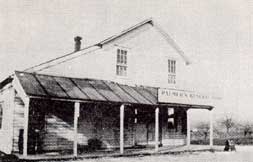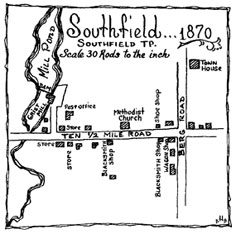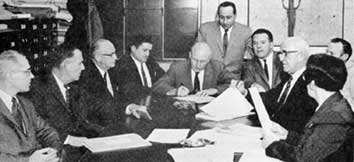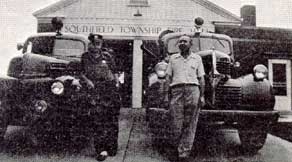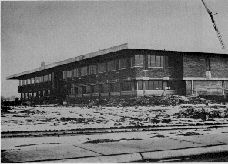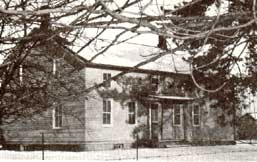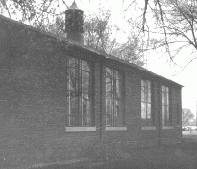In 1620, the site of Detroit was occupied by an Indian village, Teuch-so-Gion-die, and inhabited by a tribe which is today unknown. In the vicinity, however, were tribes of Hurons, Ottawas, Ojibwas, Pottawatomies, Ottagomies, Miscountins,and Twigtnees or Miamis. Here and there bands of Iroquois and other tribes also were scattered. Between 1649 and 1672, the Iroquois destroyed or sent into exile a number of tribes in the region.
Sections 8, 9, 30, and 31 were marked Indian Reservations. According to a treaty with Ottawa, etc., of 1807, these lands were given to two tribes of Pattawatmas. Each reservation was named for its Chief; the one in Sections 30 and 31 was called Tonquish; and the one in Sections 8 and 9 was called Segin Siwin. Early farmers found arrowheads in these areas, which coincides with the above information.
It is believed that most of the township's early settlers entered from Birmingham and Royal Oak. A recently discovered map from 1822 shows some of these settlers included families named Daniels, Thomas, Stoughtan, Boudens, McGaughtery, Sabins and Memlis.
Early records indicate some of the first settlers came from Fort Utica and Fort Dayton (today known as Utica and Herkimer) in the Mohawk Valley region of central New York State, as well as Newburg, New York and Rutland County, Vermont. Mostly of Irish, English, and German descent, they traveled west to Michigan by way of the Erie Canal.
John Daniels is generally acknowledged as the first settler of Southfield Township. He reportedly turned east in 1823 and brought back with him Martin and William Lee, Edmund Cook and George White. The Lees settled in Section 18, and the Cooks in the southwest quarter of Section 7 and the Whites in Section 18 near the Lees. In 1824, Rufus Hunter, the youngest son of Eliza Hunter, remembers planting three-fourths of an acre of Ohio corn.
The first child born in Southfield was the son of George White, in the fall of 1825. The first marriage was that of Benjamin Fuller, Jr. to Marietta Crawford, daughter of Abraham Crawford, in December of 1828. Not long after came the marriage of Milton Crawford, brother of the first bride, to Eliza Parker. Two other very early marriages were Thaddeus Griswold to Harriet Fuller, daughter of Benjamin Fuller Sr.; and Myrex Fuller to Miss Ives.
David Stewart, a covenanter from White Lake, Orange County, New York, came to Southfield in 1831 at the age of 65 and settled on land opposite the Caleb Jackson property a few miles southwest of Birmingham. He was the great-grandfather of Mary E. Thompson, who in 1960 sold the City 166 acres of property for the Southfield Civic Center complex. Southfield's first public library was named in his honor.
In the early years of Oakland County, the two southern townships were considered one and referred to as Bloomfield Township. On July 12, 1830, Township 1N Range 10E was designated as Ossewa Township; seventeen days later, a group of citizens petitioned the state and changed the name to Southfield. It is believed the citizens chose this name because of the township's location in the 'south fields' of Bloomfield.
Early records show the first township government was formed in the home of Benjamin Fuller. H.S. Babcock was selected as the first township supervisor. Other first officers included A.H. Green, township clerk; Benjamin Fuller, Jr. and David Brownand James Hall, assessors; Mason James, William Lee and Morris Jenks, commissioners of highways; Ebenezer Raynale, director of the poor; Thaddeus Griswold, constable and collector; George Sage, constable; and Abraham Crawford, pound master.
A town hall was built at The Burgh in the Civil Center Drive / Berg Road area in 1873. Before its construction, township meetings were held in private houses and at John Thomas' tavern, then at the ballroom of Cornelius Lawrence's hotel. After the hotel closed, meetings were held at Murphy's wagon shop and several locations. In 1933, the Southfield Post Office was established and a mail route to Birmingham opened.
On December 14, 1950, two petitions were filed at the Oakland County Courthouse in Pontiac. Mr. Kelly, of Lathrup Village, filed to incorporate his community and, minutes later, Emanuel Christensen filed to incorporate the entire township. By a margin of 85 votes, Lathrup Village voted to incorporate on May 12, 1953 and adopted a charter in December of 1953.
In September of that same year, Oak Park attempted to annex an area containing Northland. Southfield voters, however, defeated that proposal. Beverly Hills voted to become a village in 1957.
That year, Emanuel Christensen had petitions ready for circulation as soon as the most recent map could be attached. The incorporation vote came in August of 1957 and local voters approved a City Charter on April 21, 1958. At the time of incorporation, Southfield had approximately 29,000 residents.
On April 28, 1958, Southfield became a City and Reid was elected as the first municipal judge. He held that position until January of 1969, when the Municipal Court was replaced by the District Court.
Municipal judges were elected for four-year terms. The Court also had an associate municipal judge. John O'Brien was the first associate judge elected in 1958. Alex Perinoff was associate judge from 1960 to 1961 and Thomas M. Costello was associate municipal judge from 1961 to 1968.
The Municipal Court started with one employee and by 1968 had nine full-time employees. Revenue for 1968 was approximately $150,000 annually and expenses were approximately $50,000 annually.
At the beginning, the Municipal Court was located on Southfield Road near Ten Mile Road and then moved into City Hall in 1965. District Court moved into its new location in at the municipal Complex in 1980.
The 46th District Court started in January 1969 and had two full-time judges elected to six-year and four-year terms, respectively. Clarence A. Reid, Jr. was elected to a six-year term and S. James Clarkson to a four-year term.
Former Southfield Mayor Norman Feder was elected in 1972 and Jessica Cooper, the District Court's first female judge, took office in 1979. The Court also has a full-time magistrate, Michael Sobel, at that time. Today the court has 3 judges and two magistrates.
In 1971, the District Court hired Margaret Clixby as its first administrator. The second administrator was Jack Kellser, who served from 1973 to 1975. The third was Jack Hawthorne (1975-1979) and the forth, Jeffrey Amram (1980-1982).
When several segments of the township, including Southfield, incorporated during the 1950's, settlements were reached to divide the equipment and buildings. During the next 20 years, the City built five fire stations to facilitate quick response to all areas of the community. By 1982, the department's manpower had increased to 105 firefighters.
In 1972, the Fire Department added its Life Support Unit, a paramedic program to provide emergency medical assistance. This program was the first of its kind in the nation in cities of less than 100,000 population, and became a model for other programs throughout the United States. Paramedic units have been located in four Southfield fire stations since 1978.
The Southfield Police Department began in 1953 with Phillip La Vigne as its first chief. With La Vigne also as the only officer, the first department headquarters was located at the township hall at The Burgh. In 1954, the department moved to a new fire station addition at 10 Mile and Evergreen, adjacent to the then Howard Johnson's restaurant. A second officer, Milton Sackett, was added that year who later became police chief.
From August of 1958 to August of 1964, the department was headquartered in a house on Evergreen Road. In 1972, a citizen's group formed to put the question of increasing the millage for police and fire protection on the ballot. It was defeated by a small majority in the first election, but eventually received voter approval in 1973. The department moved to the Municipal Complex, where a new Public Safety Building housing a jail, administrative offices and police headquarters was opened in August of 1979. By 1982, the department had grown to 147 officers.
In her will she bequeathed $100,000 in cash to the City, from which only the interest can be used to maintain her home. The remaining 20 acres of her farm, including her home, were designated for senior citizen recreation.
City Facilities Constructed
On February 1, 1960, Southfield opened its own library in the former Brooks School building at 11 Mile and Lahser with a collection of 10,000 books. It was headed by Miss Mae Benne. Free to residents, non-residents paid a $10 fee for library cards.
Construction of the Park Services Building, located just east of the Civic Center, was completed in 1974. In that same year, Beech Woods Arena was opened at Nine Mile and Beech Roads with facilities similar to the Civic Center Arena and a Library Reading Center.
A driving range was constructed at Beech Woods in 1975 and a complete golf course opened the following year. Designed by architect Louis Redstone, the Beech Woods Recreation Center also included a children's play lot.
Parks developed in the City include Cranbrook Park (1968), Optimist Park (1965), Lahser Woods Park (1970), Valley Woods Nature Preserve (1972), Robbie Gage Memorial Park (1972), Evergreen Woods Nature Preserve (1975), Pebblecreek Park (1978), Catalpa Park (1978), Bedford Woods Park (1978), and Inglenook Park (1981).
Beginning in 1978, the Civic Center facilities were expanded to include a new Public Safety Building, a Court Building and the Southfield Pavilion, a multi-use facility with a capacity of 3,000 people. The Library, with a collection of over 150,000 books and other media, was also expanded to include a separate non-fiction level and offices. In 1982, the Library began utilizing a computerized library card system. A new state-of-the-art library opened in 2003 and offers extensive service to the residents of the city.
Southfield Government
The basic form of local government in Southfield is Council-Administrator. The Administrator is responsible for overseeing the day-to-day operations of City government and reports directly to City Council. Most department heads report to the City Administrator. City Council is the local legislative body that determines City policy, making all decisions on zoning and ordinances to protect citizens, and all legislative matters. The Mayor, the ceremonial head of City government, makes recommendations to Council, represents the City with all other legislative bodies, appoints several department heads and the City Attorney. The Mayor also has the right to veto Council actions, with five votes of City Council required to override a mayoral veto. Other elected officials include the City Clerk and the City Treasurer.
Southfield: Today and Tomorrow
Today, Southfield has grown to be the premier business and residential address in Michigan – a modern city of beautiful homes and golden skyscrapers, with a residential population of more than 76,000. Southfield’s more than 27 million square feet of office space also make it home to a daytime population of more than 175,000. In the past 60 years, Southfield has grown from a rural farming community to one of the leading business centers in Michigan and the Midwest. Few other metropolitan areas can boast such a beautiful skyline, replete with golden skyscrapers and high rises located just minutes away from quaint, tree-lined neighborhoods. As we celebrate Southfield’s history, we look fondly back on where we have come as we look optimistically forward to where we are going.
